What’s New in Post-Lockdown Paris
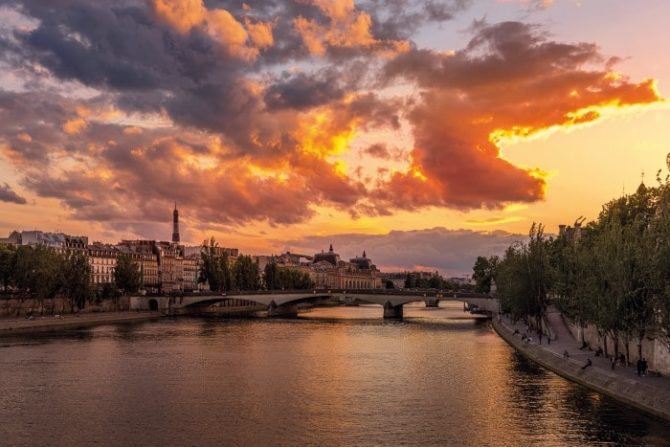

When Covid halted Parisian life as we knew it, the city did not rest on its laurels, but instead seized the opportunity to kick-start a cultural revolution guaranteed to delight today’s visitors, as Chloe Govan discovers.
Arobotic arm without so much as a head swivels around, as if awkwardly dancing, before spreading some sauce on my pizza, delivering it and deftly slicing it into four servings. Welcome to Pazzi, the first Parisian eatery to ‘employ’ robot chefs.
The company describes it as “l’expertise d’un grand chef appliquée à un robot”, and in the aftermath of the peak of the pandemic, that gesture is welcomed with open – albeit much less robotic – arms.
Masked-up guests with vaccine certification stashed safely on their phones walk up to a touchscreen to plan out their personalised pizzas from scratch. The robot takes over from there, dividing and pressing the dough, spreading the tasty sauce in circular motions and obligingly sprinkling on diners’ chosen toppings. They even disinfect their own equipment, while unusually quiet children look on in wonderment.
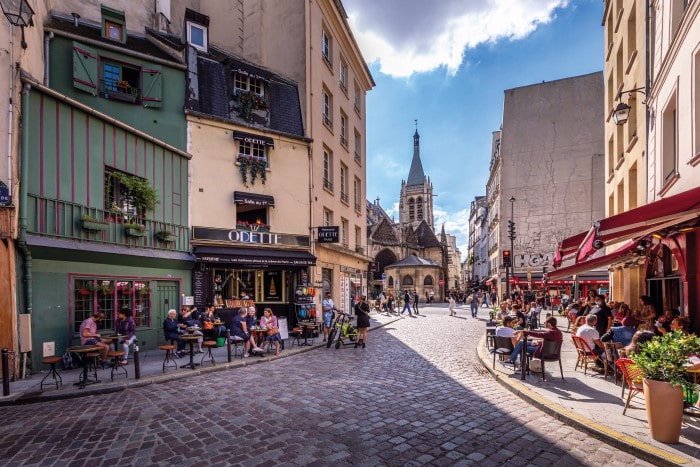
Day after lockdown due to Covid-19 in a famous Parisian cafe in Saint-Germain district in Paris. © Shutterstock
THE FUTURE IS NOW
Six pizzas at a time then disappear into tiny oven slots to be baked. After they reappear to be sliced and boxed, diners then bid the robot chef farewell, before retrieving their snacks from a lockbox-style serving hatch which is unlocked via a QR code on their phones.
The scene might give the impression of a post-apocalyptic exclusion zone devoid of human life, but it’s just one of the ways Paris has successfully adapted to a world of social distancing and zero-contact culture. Meanwhile the pizza is surprisingly delicious – even without human involvement! Alain Ducasse needn’t be fearfully looking over his shoulder just yet, though, as the army of robots looks extremely unlikely to replace the human touch or the world of Michelin-starred dining any time soon. But Pazzi does represent the very essence of 21st-century Paris right now.
Following the peak of the pandemic, there’s been a general theme of rebuilding after tragedy, whether focusing on Banksy’s artistic tribute to the tragic Bataclan terror attack, or the restoration of the centuries-old rooms where disgraced queen Marie Antoinette’s death certificate was signed – not to mention, of course, recovery from the pandemic itself.
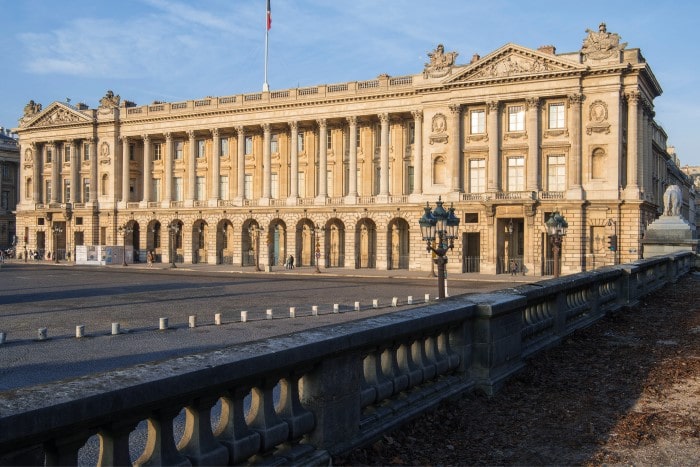
Facade sur la place de la Concorde. © Jean Pierre Delagarde/ CMN
As we tentatively renew our freedom of movement, one of the best places to see is the recently renovated Hôtel de la Marine on the Place de la Concorde. This majestic square needs no introduction, even to the most casual of Paris visitors – but did you know that one of its key historical buildings, previously closed to the public, can now be visited for a full immersion into its past? The Hôtel de la Marine has been a hotbed of violence, war, subterfuge and political unrest over the centuries. The square, originally named Louis XV in honour of the King, initially accommodated the building as a storage spot for royal furniture and collections. It was positioned directly opposite its identical sister palace, which was once home to Marie Antoinette, but now functions as the Hôtel de Crillon for those wishing to claim a small section of the royal residence as their own for a night.
Yet this particular 550-room palace had a fatal chink in its armour – one which would ultimately cause the monarchy to crumble and fall. One summer’s day in 1789, anti-monarchy revolutionaries who were feeling the heat stormed the building and seized the weapons in its arms room, before fleeing to the notorious Bastille to loot the prison of its ammunition as well. The combination of these two painstakingly planned attacks led to the first shots of the French Revolution being fired – by cannons on gun carriages gifted to Louis by the King of Siam, no less – and so it was that Hôtel de la Marine played a huge role in the city’s history and its bloodshed.
HISTORY REVIVED
In a double dose of humiliation for the royals, not only were they being violently opposed by the city folk, but they were using the impressive regal weaponry collection to do so, effectively attacking them with their own wealth.
The unrest prompted Louis XVI to leave the Château de Versailles and relocate to the city, installing naval commanders in the Hôtel de la Marine. But even they failed to keep out invaders when, in 1792, the building was looted again. This time the crown jewels and other valuables at a total of 30 million francs were seized by a group of revolutionary bandits.
With their wealth plundered, it was now only a matter of time before a takeover. The following year, Louis XVI fell prey to the baying crowds fighting for change. They had torn down Place de la Concorde’s statue of Louis XV and temporarily restyled the square as Place de la Révolution. It was here on January 21, 1793, that the king was beheaded as terrified locals peeped out from behind the curtains of the Hôtel de la Marine. Nine months later on October 16, 1793, Marie Antoinette met the same gory fate when she followed her husband to the guillotine.
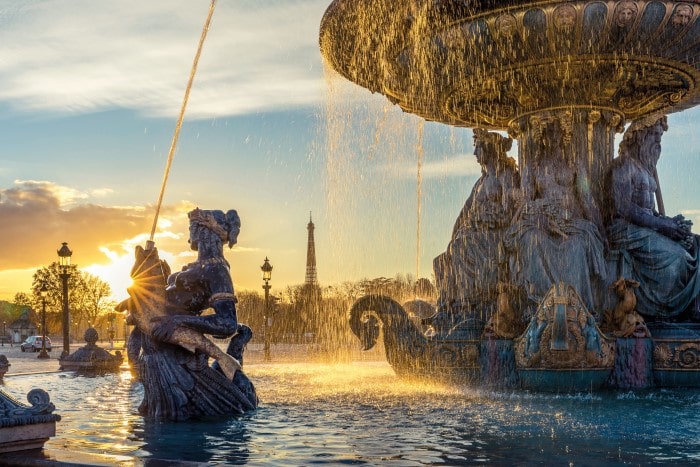
Place de la Concorde. © Shutterstock
Also that year, a slave rebellion broke out in one of France’s overseas territories, Saint-Domingue; thus a challenge to France’s ruling classes from all angles had officially – and often very graphically – been launched.
However, France, along with Britain, had been rallying to eradicate slavery for some time and in 1848, in this same building, a treaty for its abolition was signed. It would be the most significant signing there since Marie Antoinette’s death certificate.
The building continued to house the navy for two centuries, with the exception of a period during the Second World War, when invading Nazi soldiers seized it, installing small spy holes in the window shutters to keep watch for enemies. In 2015, the navy left and the painstaking work began to restore the 18th-century apartments within to their former glory. An authentic reconstruction of a Garde-Meuble intendant’s original apartment, decorated with cherubs, can still be seen and, according to overseeing architect Joseph Achkar, “the 18th century wallpapers and textiles we chose were almost as good as new… It is as if Pierre-Élisabeth de Fontanieu [the intendant from 1767 to 1784] had never left”. Meanwhile the 19th-century chandelier-embellished salon of the admirals is a competent rival to the famed Hall of Mirrors at the Château de Versailles.
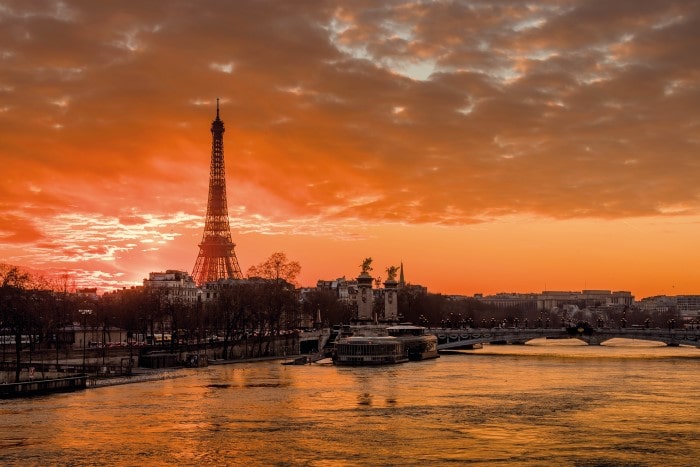
Paris cityscape in winter. © Shutterstock
NEVER BEFORE SEEN
There is an enormous amount of history housed here, from the 1700s to the present day, and tours guided by headsets immerse you in the enthralling historical events of the past while you stand in the locations where they took place. Open to the public for the first time ever following a €132m makeover, this is an absolutely unmissable stop on any return visitor’s Paris itinerary. The Place de la Concorde itself is also undergoing major renovation, with a €250m redesign being undertaken this year to get it ready for hosting the 2024 Olympics.
It all provides an excellent example of how, after tragedy and turmoil, Paris has been rebuilding itself for the future, while also paying tribute to its past. Many are adding to that theme in the present day, including Banksy and the reflective messages about society that appear in his artwork.
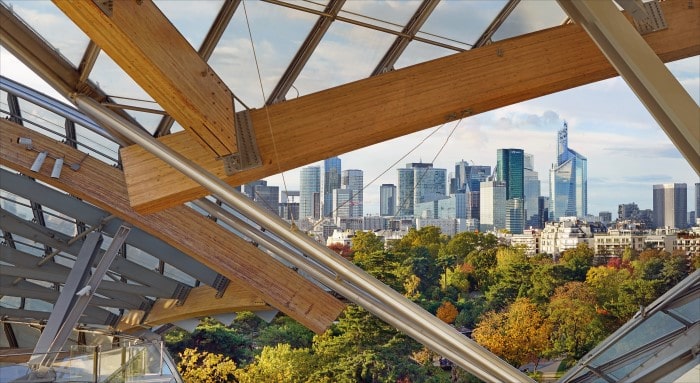
Views from la Fondation Louis Vuitton By Jean-Pierre Dalbéra © Wikimedia Commons
The Bristol-born illustrator, who is currently the subject of an immersive exhibition at the Espace Lafayette-Drouot, captured French hearts with his touching tribute to the victims of the 2015 terrorist attacks at the Bataclan music venue. He has, however, not hidden his anarchist mindset or his politically outspoken metaphors. One of his France-specific works is his remake of Jacques-Louis David’s ‘Napoleon Crossing The Alps’, in which the Emperor gallops astride a horse, but with the addition of a red headscarf obscuring his face. Many have interpreted this as a commentary on France’s 2010 ban on face coverings in public, which angered many of the country’s Muslim population. Banksy’s work has also addressed Covid, speaking on behalf of the many millions whose lives were turned upside down by it, and a visit to this ultra-modern exhibition comes highly recommended.
Needless to say, there has been a dramatic resurgence in art and entertainment since the birth of the Covid vaccine and visitors seeking an art kick have plenty of new exhibitions to choose from in the city. As well as a new display on the legacy of the ancient Greeks, the Louvre is also holding one named ‘From Afar’, commemorating the many collections worldwide travel has blessed us with, from ivory to lapis lazuli. Anyone wishing to contemplate the fruits of ancient journeys, particularly now that travel is finally possible again, should greatly enjoy it.
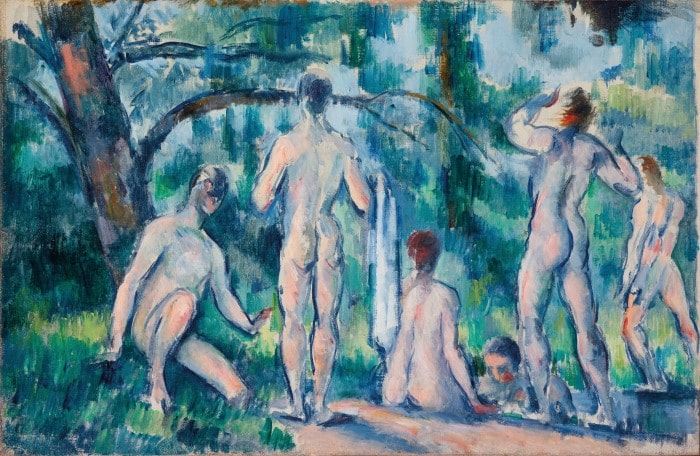
Cezanne artwork at the Morozov exhibition. © Fondation Louis Vuitton
Other treats to look forward to include Russian businessman Ivan Morozov’s vast collection of European art at the Fondation Louis Vuitton, and a collection of Botticelli’s best work sourced from galleries as renowned as the Louvre and the Vatican, hosted at the Musée Jacquemart-André.
FASHION FORWARD
On the fashion side, there are three major unmissable exhibitions that stand out from the crowd. At La Cinémathèque, ‘CinéMode’ sees Jean Paul Gaultier showcase some of his own creations for the silver screen, plus James Bond’s tuxedo, one of Marilyn Monroe’s dresses and more besides. Most famous for the conical bra he produced for Madonna, which he had first fashioned for his beloved teddy bear as a child, Gaultier’s 50-year career in fashion and love of cinema makes for a fascinating exhibition.
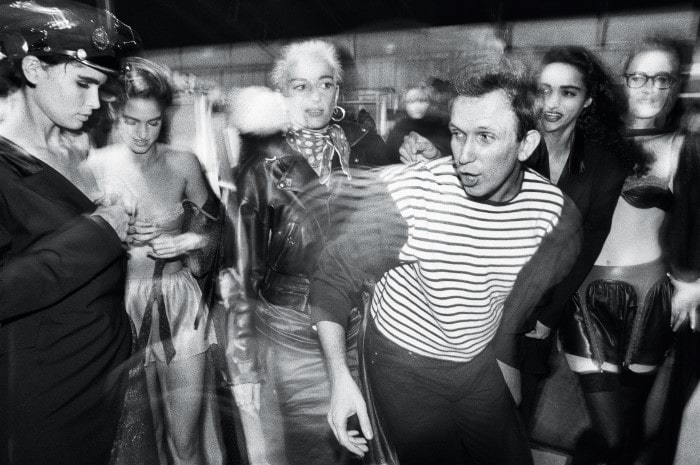
Throwback photo of Jean Paul Gaultier backstage with his models, photo can be seen at the Cinematheque exhibition © William Klein
Meanwhile, following a century of leadership in the style ranks, France’s oldest fashion magazine takes the stage in a display devoted to ‘100 Years of Vogue’. The exhibition features framed photographs of Vogue models from David Bowie to Kate Moss, plus an exhaustive catalogue of outfits from the androgynous bobs and masculine-tailored outfits of the 1920s to the exaggerated femininity of the Dior years, with tiny corseted waists and huge, flamboyant peplum waists – plus everything in between! The great designer Thierry Mugler recently passed away, and you can pay homage to his wearable art at an exhibit at the Musée des Arts Décoratifs. From corsets with motorbike engine illustrations on the front, inviting those who wear them to ‘rev up their engines’, to feathered costumes that would befit a peacock, his creations are not merely outfits but art pieces which wouldn’t look out of place on Lady Gaga.
This resurgence in shared culture, something which society has sorely lacked during the pandemic, with the exception of creative exchanges via the internet, will make Paris the place to be during 2022.
Plus the lavish refurbishment and subsequent reopening of the famous shopping and dining spot La Samaritaine will help bring visitors back to the city and deliver a much-needed boost to the economy.
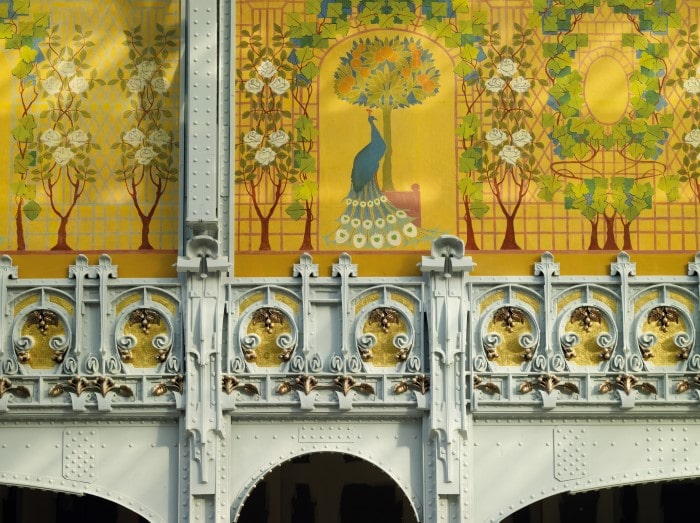
Samaritaine decor, Peinture des paons © Pierre-Olivier Deschamps, Agence VU
A GREENER CAPITAL
Meanwhile, the modern trend of making more conscientious decisions for a healthy future, which was unsurprisingly exacerbated by the pandemic, has surfaced in terms of environmentally friendly changes too. For instance, the forthcoming eco-friendly 1 Hotel, devised by leading Japanese architect Kengo Kuma, will show its face next year as a “green lung” for the city, blending angularly patterned panels of wood with forest-like groups of plants. Aesthetically dazzling, it’s one to book for 2022.
Mayor Anne Hidalgo has even announced plans to ban through-traffic in four major central districts to dramatically reduce traffic in the capital and create a healthier, less crowded Paris. Some 50km of new cycle lanes have emerged across the city and ever more areas, such as the rue de Rivoli and the banks of the Seine, have become off-limits to cars. Landmarks such as the Eiffel Tower and the Champs-Élysées are being given green makeovers and new urban forests are planned for points around the capital.
Since the pandemic, society has dramatically changed generally – from the self check-in function at hotels such as the new CitizenM Champs-Élysées to pizzerias staffed by robot chefs to a proliferation of new pavement seating at cafés and restaurants. To borrow a pandemic-era cliché, Paris is indeed “building back better” by delving deeper into its multi-faceted history to find the silver lining in its recent suffering. On your next visit, you’ll find yourself part of a refreshing cultural revolution.
From France Today magazine
Share to: Facebook Twitter LinkedIn Email
More in Covid, history, news, Paris
By Chloe Govan
Leave a reply
Your email address will not be published. Required fields are marked *




REPLY